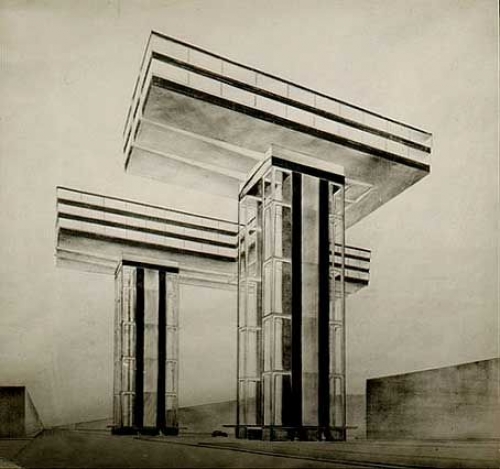'We want art back, the new art of architecture'

'A model of clear thinking and informed comment' - Nick Wright reviews the Imagine Moscow exhibition at the Design Museum.
“The position is this: the ecstatic period of the revolution is over. Now it's the working day — but art is holiday. And we want art back, the new art of architecture,” artist and designer El Lissitzky declared in 1925. This intelligently conceived exhibition revisits that spirit of daring innovation and unbounded optimism which accompanied the accession to state power of Russia’s working class, ushered in by the 1917 Russian revolution.
Buried deep in the Design Museum basement, a series of fluid spaces locate each of the designs for six utopian and uncompleted projects in an architectural, social, political and aesthetic context by assemblies of drawings, plans, documents and illustrations of the post-revolution period. In conception, Ivan Leonidov’s 1927 Lenin Institute is simultaneously rooted in the technologies of the time and moulded by extravagantly utopian and untested technique. A pre-internet storehouse of knowledge and a radio station, it was to be served by a metropolitan aero-tram system. Its synthesis of architectural and political ambition hint that the global revolution might have progressed differently if the Comintern had had at its disposal both social media and television.
El Lissitzky’s Iron Cloud (1923-1925) reworks, from the early years of the revolution, the model of integrated housing, transport, services and work with a new skyscraper technology which prefigures contemporary big-city style, while Boris Iofan’s winning entry for the Palace of Soviets competition conveys something of the optimism of the time. Designed to be the tallest building in the world, topped by a 100-metre statue of Lenin, it was to sit on the site of Moscow's Cathedral of Christ the Saviour. The project started in 1931, just as Stalin warned that the USSR had a decade to prepare for Western invasion. But, by 1941, political realism allowed its uncompleted structures to be recycled to fortify the city against the nazi invaders. Later, the foundations became a swimming pool and now Russia’s new bourgeoisie worship in a replica of the cathedral built on the site.

Lenin's statue in the Palace of the Soviets
The utopian spirit of these Soviet pioneers is predicated on a sense that transformed social relations produce a new human being. But, as the world revolution faltered, the bourgeoisie weaponised its fascist auxiliaries and, as the problems of building a socialist society demanded answers, new ways of transforming social actions presented themselves. The very magnitude of the problems necessitated prodigious efforts to mobilise the human and material resources of the socialist state. Thus there were over 100 entries for the competition to design a Commissariat of Heavy Industry, with Yakov Chernikhov’s 1933 Architectural Fairytale echoing Lenin’s telling phrase: “Communism is Soviet power plus the electrification of the whole country,” while Konstantin Melnikov’s two 40-story buildings, connected by a futuristic external escalator, were to be decorated with sculptures representing the successes of the first and second Five Year Plans.
The idea of communal living was rooted in the appropriation of the spacious dwellings of the bourgeoisie. Those utopian and revolutionary ideals were shaped to advance the liberation of women through their entry into social production more fully and to render domestic labour less oppressive. Communal kitchens, leisure facilities, laundries, nurseries and restaurants were conceived as state-sponsored instruments designed to enhance women’s education and intellectual development. Nikolay Ladovsky’s Communal House transmutes this into utopian form through a spiral structure echoing the dialectical thrust of Vladimir Tatlin's Monument to the Third International. The focus on healthy living for the whole person finds direct expression in Health Factory, Nikolay Sokolov’s plan for a seaside complex designed to restore workers’ productive well-being through structured vacations, recreation, sport and medicine.

Nikolay Ladovsky’s Communal House
The one project which did reach completion in 1930 is Alexey Shchusev’s Lenin Mausoleum, in which the Soviet leader's body lies in a sarcophagus designed by Konstantin Melnikov. Distinctive though the modernist building is, the materialist world view might be better served if successive Soviet leaders had done what Lenin asked and buried him alongside his mother. The contextual material to the exhibition is excellently presented, with useful accounts of debates in which architects and planners, artists and ideologues, futurists and functionaries argued out their competing priorities.
While there are examples of cold war and unreflective petit-bourgeois prejudice in the exhibition and the excellent accompanying book, in comparison to other stuff with which we are assailed this anniversary year, Imagine Moscow is a model of clear thinking and informed comment.
Runs until June 4, box office: designmuseum.org. This review was first published on morningstaronline.co.uk

Nick Wright
Nick Wright is an editor at Manifesto Press, blogs at 21centurymanifesto and is responsible for the Communist Party’s media work.
